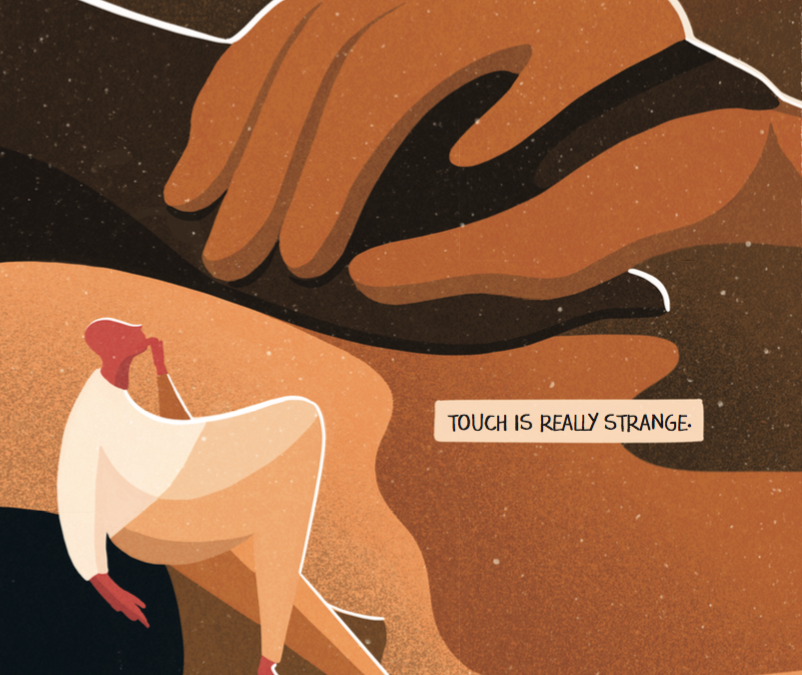Touch is stranger and more powerful than often assumed. A lot of what we have thought to be true about touch, particularly as body workers, is now being re-thought. And in the time of COVID-19 conversations about how to touch, and the importance of relational touch are more important than ever.
Touch can help us meet our wordless places in a way that is hard to access through conversation alone. Slow, relational touch can help us shift our emotional core and release us to feel alive.
In this blog I celebrate the power of touch works, and share five reasons why it is such an important tool to ease anxiety, pain and trauma.
1. All human beings need touch to thrive
There is strong and devastating evidence about the negative consequences of an absence of touch. A lack of touch was a major feature in the neglect, suffering and poor health of orphans in Romania in the 1980s. Children without touch, stimulation, and nurturing can literally lose the capacity to form any meaningful relationships for the rest of their lives.
In their book, Touch in Child Counseling and Play Therapy, Courtney and Nolan write, ‘the role of touch and sensory input in attachment is paramount and includes holding, rocking, feeding, gazing, and physical proximity’.
Old people have also been seen to fare worse without touch. The Elder Care Alliance write ‘an absence of human touch can cause negative physical and emotional effects for older adults. Without human touch, elders are at increased risk of anxiety, feeling isolated, lowered trust in care partners and decreased awareness of the senses’.
2. Touch is one of the ways we first learn about the world
We learn about the world, and all the fundamental constructs that make up our world through touch and embodiment, rather than through language. Appreciating this wordless knowing is important. Selfhood is not formed by contemplation and applying words to experience – that comes much later.
Passing through the birth canal is probably one of the hardest things we ever did. The pushing, resistance and forces we experienced calibrated our threat detection systems as to what is too quick, too slow, too hard, too much.
As we grow, our earliest concepts and sense of self are shaped through action, touch and embodiment. We meet edges and things that resist, we bang ourselves on things when we fall over, and on the other hand, we (hopefully) experience warm, soft heartbeats and the safety of other bodies.
Skin-to-skin contact is now universally recommended to help babies thrive. It calms and relaxes both mother and baby, regulates the baby’s heart rate and breathing, and reduces stress.
‘Kangeroo care’, where the baby is held against the bare chest, saves pre-term babies’ lives. In a report by Feldman et al, they concluded, ‘Children receiving Kangaroo Care showed attenuated stress response, improved respiratory sinus arrhythmia, organized sleep, and better cognitive control’.
3. Touch is social glue
Interpersonal touch is a crucial form of social glue. In his 2015 book, Touch: The Science of Hand, Heart, and Mind, Linden found that NBA basketball teams that shared more touches early season performed better for the whole season; ‘celebratory touch…was associated with higher performance’.
Dacher Keltner (2009), an influential emotion researcher, writes that everyday gestures, such as a pat on the back or a caress of the arm, are ‘far more profound than we usually realize’. Touch ‘is the primary language of compassion, love, and gratitude’.
4. Touch reinforces our humanity and creates safety
Touch can be used as a tool to feel connected, particularly if, instead of using the old model of ‘touching to do something to someone’, we think of touch as a fundamental reinforcing of our humanity.
For touch to be a force for good in this way, we need to be very present with ourselves and with the other. We need to create a space where touch can be safely received at the deepest levels of experience.
When we do this, touch helps people feel more connected to their bodies, and reconstruct their idea of their body as a safe place, which helps to switch off their danger mechanisms of anxiety or pain, and feeling stuck, overwhelmed and lost in trauma.
5. Slow, relational touch, can relieve pain, trauma and anxiety
In trauma, pain and anxiety, touch can be a safe, novel stimulus to access new possibilities in our physiology. Just the simple act of hand-holding can lead to less pain via ‘interpersonal synchronization’ of brain waves, heart rate and breathing.
Our brains tend to be gloomy: bad experiences receive far more attention than good ones. Relational touch can provide a stimulus to move away from these habitual, doom-laden feelings like fear, contraction and isolation towards play, expansion and community.
************************************************
Upcoming Events with Steve:
Want to learn a simple, self-help tool for tension and trauma? Try TRE
TRE Intro Days Online: 30 Sep 2021
TRE Online Certification Training:
TRE Module 1 Online 21-22 Sep & 4 & 5 Dec
TRE Module 2 Online 14 & 15 Dec
TRE Module 3 Online 20 & 21 Nov & 15 & 16 Mar 2022
Biodynamic Craniosacral Therapy Training 2 year trainings:
London 2021 Seminar 1 starts 15-19 Sep 2021
Galway 2021 Seminar 1 starts 22-26 Sep 2021



Thanks Steve, its good to be reminded and have reinforced the power of the gift of touch.